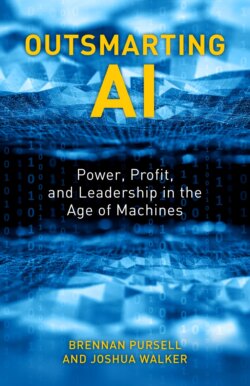Outsmarting AI

Реклама. ООО «ЛитРес», ИНН: 7719571260.
Оглавление
Brennan Pursell. Outsmarting AI
Foreword
Acknowledgments. Brennan:
Joshua:
Introduction
AI Is Brainless
We Wrote This Book for People like You
How to Read This Book
7 AI Myths, 7 AI Rules
Myth 1: AI Is a Robot
Myth 2: AI Knows What It’s Doing
Myth 3: AI Is Inescapable
Myth 4: AI Has Insight
Myth 5: AI Means Easy Money
Myth 6: AI Drives Businesses
Myth 7: AI Will Control Your Mind
Rule 1: Data Is the Mother of AI
Rule 2: Math Is the Father of AI
Rule 3: AI Systems Are like Kids—They’re All Unique
Rule 4: AI Needs Parenting
Rule 5: Embrace the Cyborg
Rule 6: Platform Is the Key
Rule 7: Abide by the Law and Act Ethically
AI in Plain English
The Math of AI
The Software of AI
AI Applications. in Business. AI Bonanza
AI Functions
AI Accessibility
AI Cloud Companies
Microsoft
Alphabet (Google)
Amazon
IBM
Cloud Storage AI
Apple and Facebook
Don’t Forget the Hardware
AI Applications by Sector
Marketing: Advertising and Sales
Customer Support
Medical
Finance and Insurance
HR
Supply Chain Management and Transportation
Education
Agriculture
Surveillance and Security
Military AI
AI Success in Your Organization
Keep it Simple: Make Money
PLAN like an Accountant and a Leader
ORGANIZE According to Plan
LEAD like a General, and a Servant
CONTROL in Order to Know
Initiate Organization Movement toward AI
Identify Potential Deployments of Automated AI Tools
Master Your Data
Look under the Hood
Govern Your AI
AI Governance. and Data Controls. The AI “Event Horizon”
Tools, Not Governors
Security Is a Design Problem
What to Do? Two Things, Plus EDEN
Governing AI—Kubernetes / Control Systems
“Outsmarting” AI Means Leveraging AI
As Above, So Below: Two Nerd Languages
Network Effects for Big Data
On Building AI
What It Takes to Make AI “Magic”
The EDEN Method
On Data Control
The “U” in “AI”
Wrong Terms and “U”-Turns
Compliance, Progress, Arts Financial
Data Control in Practice
Data Control Principles
Commonsense AI
EDEN Case Studies
Lex Machina EDEN Application
FinCity EDEN Application
Data Control Applied to Cases
Lex Machina Data Control
FinCity Data Control
The Politics of AI
Back to the Bar
Afterword: Mind the Gap
What Is Ethics?
Doing Good and Avoiding Evil
Ethics and AI
The Master–Slave Dilemma
Relevant Questions
“Rappaccini’s Daughter”
Relevant Questions
Epistemological Bias
Relevant Questions
Manipulation and Marginalization
Relevant Questions
Best Practices
Further Resources
Bibliography. Books and Articles
Websites
Index
About the Authors
Отрывок из книги
Sean Kanuck, former US National Intelligence Officer for Cyber Issues
Everyone needs to grasp the impact of emerging technologies on their lives, organizations, and societies in order to survive and prosper. The impending combination of information technology (IT), nanotechnology, and biotechnology will literally change life as we know it—in almost every respect. The scale and scope of that change will be monumental. Not since mankind gained command over fire have humans been in an equally powerful position to transform our own existence. The ability to cook food altered our bodies, and the ability to forge metal defined early cultures. But, at the same time, certain aspects of our identity and experience remained constant (e.g., reproduction, consciousness, mortality). The same will be true for the foreseeable future of this technological revolution.
.....
Data is where every AI system begins. AI depends on data quality and quantity. “Garbage in, garbage out,” is still the rule. From biased data come biased results, bad business decisions, and big potential legal problems. You will need to bestow a lot of love on your data. You need to compile it, integrate it, and shatter the silos that prevent you from bringing it together. You will need to prepare it, repair it in places, and maintain it.
You will have to work with both “structured” data—the type your algorithms can search and query easily—and “unstructured” data—pretty much everything else—the kinds of things you can readily understand but a computer really can’t. Entries in tables for names, addresses, purchases, etc., are typical of structured data. Unstructured data include texts, posts, images, sound clips, and videos. These files, while digitized like everything else on a computer, are not neatly arranged into rows and columns. An AI system will have to do a lot of calculations to classify what’s in them, but you can train it, and dumb as it is, it works immeasurably faster than you do.
.....